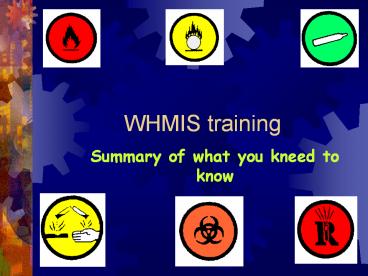WHMIS training - PowerPoint PPT Presentation
Title:
WHMIS training
Description:
WHMIS training Summary of what you kneed to know What is WHMIS ? The Workplace Hazardous Materials Information System (WHMIS) is Canada's hazard communication standard. – PowerPoint PPT presentation
Number of Views:733
Avg rating:3.0/5.0
Title: WHMIS training
1
WHMIS training
- Summary of what you kneed to know
2
What is WHMIS ?
- The Workplace Hazardous Materials Information
System (WHMIS) is Canada's hazard communication
standard.
3
What are the main parts of WHMIS?
- The main components of WHMIS are
- hazard identification and product classification,
- labelling,
- material safety data sheets, and
- worker training and education.
4
Why was WHMIS created?
- It was created in response to the Canadian
workers' right to know about the safety and
health hazards that may be associated with the
materials or chemicals they use at work.
5
- Exposure to hazardous materials can cause or
contribute to many serious health effects such as
effects on the nervous system, kidney or lung
damage, sterility, cancer, burns and rashes.
6
- Some hazardous materials are safety hazards and
can cause fires or explosions. - WHMIS was created to help stop the injuries,
illnesses, deaths, medical costs, and fires
caused by hazardous materials.
7
What are controlled products?
- Controlled products is the name given to
products, materials, and substances that are
regulated by WHMIS legislation. - All controlled products fall into one or more of
six WHMIS classes.
8
The 6 WHMIS classes
- 1. Class A Compressed gas
- 2. Class B Flammable and Combustible material
- 3. Class C Oxidizing material
9
- 4. Class D Poisonous and Infectious materials
- Division 1 (D1) - Materials Causing Immediate and
Serious Toxic Effects - Division 2 (D2) - Materials Causing Other Toxic
Effects - Division 3 (D3) - Biohazardous Infectious Material
10
- 5. Class E Corrosive material
- 6. Class F Dangerously Reactive material
11
Labeling controlled products
- Under WHMIS regulations most controlled products
must be labeled. - Supplier labels and workplace labels are the only
two types used in WHMIS. - All WHMIS labels have to be clear, easy to read
and prominently displayed on the product
container.
12
Supplier labels
- Display these seven pieces of information
- material identification number or product name -
this is a designation or identification of a
material, - supplier's name and address,
- reference to the material safety data sheet
(MSDS) for more information, - WHMIS hazard symbols for each of the classes to
which the product belongs,
main hazards of the product including risk
phrases appropriate to the class of material,
precautionary measures, first aid measures.
13
Workplace labels
- This label does not need as much information as
the supplier label - material identifier or product name,
- reference to a material safety data sheet (MSDS)
for further information, - information on how to use the product safely.
14
Material Safety Data Sheets (MSDSs)
- WHMIS MSDSs have nine categories
- of information
- Section 1 - Product Information including
identification and use - Section 2 - Hazardous Ingredients listing of
ingredients considered hazardous as well as each
ingredient's concentration, etc. - Section 3 - Physical Information form, odor,
appearance, pH, etc. - Section 4 - Fire or Explosion Hazard conditions
of flammability, flash point, etc.
15
- Section 5 - Reactivity Information conditions of
instability, reactivity, decomposition, etc. - Section 6 - Health Hazard Information route of
entry, effects of exposure, exposure limits, etc.
- Section 7 - Preventive Measures personal
protective equipment, waste disposal, storage,
etc. - Section 8 - First Aid Measures
- Section 9 - Preparation Information and Update
person who wrote MSDS, date of preparation
16
WHMIS is Law
- WHMIS became law effective October 31, 1988. This
applies to all of Canada. - WHMIS legislation includes
- the HAZARDOUS PRODUCTS ACT and
- the HAZARDOUS MATERIALS INFORMATION REVIEW ACT.
- In Newfoundland
- Occupation Health and Safety Act
- Workplace Hazardous Materials Information System
(WHMIS) Regulations
17
What are our duties under WHMIS?
- Suppliers, employers and workers all have
specified responsibilities in the Hazardous
Products Act.
18
A Suppliers duty...
- Canadian suppliers are those who sell or import
products. - When this product is considered a "controlled
product" according to the WHMIS legislation, a
supplier must label the product or container, and
they must provide a material safety data sheet
(MSDS) to their customers.
19
An Employers duty...
- Employers are required to establish education and
training programs for workers exposed to
hazardous products in the workplace. - Employers must also make sure that the products
are labeled and that an MSDS is present for each
product and that they are readily available to
workers.
20
A Workers duty...
- Workers are required to participate in the
training programs and to use this information to
help them work safely with hazardous materials. - They may also inform employers when labels on
containers have been accidentally removed or if
the label is no longer readable.
21
On-line WHMIS training
- http//access.nscc.ns.ca/safety/whmis.htm
- Where to find WHMIS symbols
- http//www.hc-sc.gc.ca/hecs-sesc/whmis/whmis_symbo
ls.htm - Where to find Hazardous Household Product
Symbols - http//www.region.peel.on.ca/pw/waste/resident/hhw
.htm
22
Know WHMIS symbols and the nine MSDS categories
- Know the Hazardous Household Product Symbols































